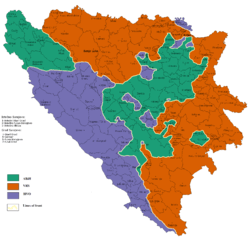Bosnian Muslim Republic
A Bosnian Muslim Republic,[a] that is, consolidation of Bosniak-inhabited territories into a Bosniak nation-state, was proposed during the Bosnian War when plans for the partition of Bosnia and Herzegovina were made. It would either be established as one of three ethnic states in a loose confederation,[1] or as an independent "Muslim state" in the area controlled by the Bosnian Army, as proposed by Islamists.[2] Thus, the Bosniak-inhabited territories or Bosnian Army-controlled area (the Republic of Bosnia and Herzegovina) would become a Bosniak state, as Republika Srpska was for the Bosnian Serbs and Herzeg-Bosnia for the Bosnian Croats. The failed 1992 Serb–Croat Graz agreement would see a small Bosniak buffer state, pejoratively called "Alija's Pashaluk" on a map displayed during the discussions.[3] The Owen-Stoltenberg plan (July 1993) would give Bosniaks 30% of territory, including ca. 65% of the Bosniak population (according to the 1991 census).[1] In February 1994, the Party of Democratic Action (SDA) proposed a Bosniak state in which Serbs and Croats would be national minorities.[2] The Dayton Agreement (November–December 1995) ended the war and created the federal republic of Bosnia and Herzegovina (BiH), made up of two entities, the Bosniak and Croat-inhabited Federation of Bosnia and Herzegovina (FBiH), and the Serb-inhabited Republika Srpska (RS). As noted by international relations expert Niels van Willigen: "Whereas the Bosnian Croats and Bosnian Serbs could identify themselves with Croatia or Serbia respectively, the absence of a Bosniak state made the Bosniaks firmly committed to Bosnia as a single political entity."[4]
Propaganda texts appeared in 1996, after the war, calling for a Bosniak state.[5] Secular Bosniaks have warned that a partition of the state would lead their people to Islamic fundamentalism.[6] There has been proposals of secession of RS, as well as its abolition.
-

Ethnic composition in 1991
-

Military control before Dayton (1995)
-
.png)
Ethnic composition in 2005
See also
- Zulfikarpašić–Karadžić agreement
- Partition of Bosnia and Herzegovina
- Peace plans proposed before and during the Bosnian War
- Proposed secession of Republika Srpska
Annotations
- ^ Also called "Bosniak Republic" (Bosnian: Bošnjačka republika), "Muslim Republic" (Serbo-Croatian: Muslimanska republika), and "Bosniak-Muslim republic" (Bošnjačko-muslimanska republika),[7][8] or simply "Bosniak state" (Bošnjačka država).
References
- 1 2 Kostić 2007, p. 78.
- 1 2 Velikonja 2003, p. 278.
- ↑ Blaine, Harden (1992-05-08). "Warring Factions Agree on Plan to Divide up Former Yugoslavia". The Washington Post. Retrieved 2009-08-11.
- ↑ Niels van Willigen (18 July 2013). Peacebuilding and International Administration: The Cases of Bosnia and Herzegovina and Kosovo. Routledge. pp. 52–. ISBN 978-1-134-11725-3.
- ↑ FBIS Daily Report: East Europe. The Service. 1996. p. 20.
- ↑ Timothy Garton Ash (2000). History of the present: essays, sketches and despatches from Europe in the 1990s. Penguin. p. 374. ISBN 978-0-14-028318-1.
- ↑ Trnka 2000, p. 40.
- ↑ Rusmir Mahmutćehajić (1998). Kriva politika: čitanje historije i povjerenje u Bosni. Radio Kameleon. p. 19. ISBN 978-9958-9659-0-6.
Sources
- Kostić, Roland (2007). Ambivalent Peace: External Peacebuilding Threatened Identity and Reconciliation in Bosnia and Herzegovina. Ambivalent Peace. pp. 78–. ISBN 978-91-506-1950-8.
- Trnka, Kasim (2000). Konstitutivnost naroda: povodom odluke Ustavnog suda Bosne i Hercegovine o konstitutivnosti Bošnjaka, Hrvata i Srba i na nivou entiteta. Vijeće Kongresa bošnjačkih intelektualaca. ISBN 978-9958-47-072-1.
- Velikonja, Mitja (2003). Religious Separation and Political Intolerance in Bosnia-Herzegovina. Texas A&M University Press. pp. 278–. ISBN 978-1-60344-724-9.
Further reading
- Ajanović, M. (1995). [Manifesto of a Bosniak republic]. Tuzla.